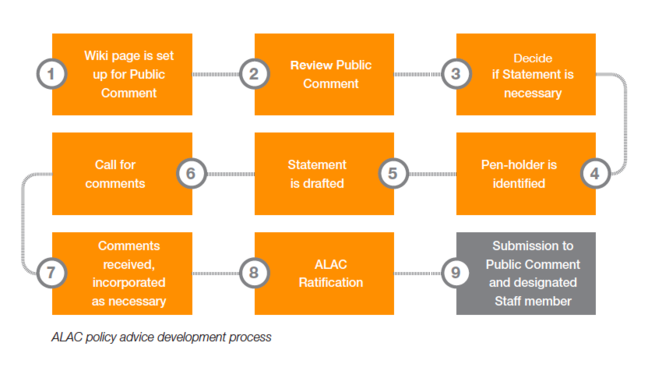At-Large Advisory Committee
The At-Large Advisory Committee (ALAC) is one of ICANN's Advisory Committees. The mission of ALAC is to function as an advocate for the interests of individual Internet users.
Overview[edit | edit source]
The 15-member ALAC represents the At-Large Community and consists of two members selected by each of the five RALOs and five members appointed by ICANN's Nominating Committee. The committee is tasked with advocating for the interests of end-users, advising on the Internet policies developed by ICANN's Supporting Organizations, and selecting a director to serve on the ICANN Board. ALAC also plays a significant role in ICANN's outreach and engagement programs.
History[edit | edit source]
The ICANN Board adopted new bylaws on October 31, 2002, which came into effect on December 15, 2002. The creation of the ALAC was part of a larger reform effort within ICANN, now known as ICANN 2.0. The new bylaws established the ALAC and provided support for At-Large Organizations. It stated that the ALAC should consist of ten members selected by Regional At-Large Organizations, with five supplementary members to be selected by ICANN's Nominating Committee. The interim ALAC consisted of ten members, two from each of ICANN's 5 regions.[1]
In her testimony to the Senate Committee on Commerce, Science & Transportation on December 8, 2011, Esther Dyson, former Chair of the ICANN Board and ALAC member, noted the difficulty of representing the average Internet user within ICANN, even with the ALAC. Specific problems included recruiting members and fostering productive message boards and long-distance communications.[2] Since then, ALAC has focused its attention on addressing these issues, among others, to cultivate more and better participation by end-users in the At-Large Community.[3]
The Role of the ALAC[edit | edit source]
In accordance with ICANN Bylaws, the ALAC is charged with understanding, representing, and advocating for the best interest of Internet end users worldwide. The ALAC focuses on two general areas of work: policy advice development and organization building.[4]
Policy Advice Development[edit | edit source]

The ALAC does not develop policy; it publicizes, analyzes, and provides advice on ICANN policy proposals and decisions. Public Comment proceedings are the main channel through which the ALAC advises ICANN. It also corresponds with and responds to input requests from other ICANN body working groups.
When a new Public Comment opens, the ALAC consults with subject matter experts within the At-Large Community to decide if it should make a statement on the topic. It uses mailing lists, RALO, and working groups to build consensus. Then, the ALAC determines who should be the “penholders,” the individuals responsible for the initial draft of the statement to be submitted to the Public Comment. The completed draft is posted on the ALAC Wiki workspace for comment and then it is finalized. Then the 15 ALAC members ratify and submit the document to the Public Comment as a formal ALAC Policy Advice Statement.
Organization Building[edit | edit source]
The ALAC seeks to ensure sure that all ALSes and individual members understand ICANN’s mission and core value, contribute to policy developments, and sustain the flow of end-user volunteers into the Multistakeholder Model of ICANN. The committee does in three ways: capacity building, outreach, and operational matters, all of which focus on cultivating RALOs and ALSes. The most formalized of the ALAC’s means is its operational contributions, which include:
- ALS accreditation
- Meeting planning for ALAC, RALOs, and At-Large working group sessions during ICANN International Meetings.
- Budget request review from RALOs for outreach, engagement, or capacity building
- Selection of members – Evaluate and confirm candidates selected from the At-Large Community as delegates to the NomCom and Cross Community Working Groups
- Organizational review
At-Large Structures[edit | edit source]
- Main article: ALS
The ALAC represents a network of regionally self-organized and self-supporting At-Large Structures, which represent individual Internet users throughout the world. The At-Large Structures are divided into five Regional At-Large Organizations (one in each ICANN region – Africa, Asia-Pacific, Europe, Latin America/Caribbean, and North America). These RALOs manage public involvement and represent their constituents to ICANN.[5]
Through these At-Large Structures, individual internet users have been given a voice and a space whereby they can influence the policy decisions made by ICANN.[6]
ALAC responsibilities[edit | edit source]
Besides following the provisions of ICANN's new bylaws, ALAC has responsibilities such as assisting the formation and qualification of other At-Large Structures and RALOs. Other responsibilities undertaken by ALAC and its organizations include:
- Evaluating the accreditation process for At-Large Structures
- Analyzing and publishing ICANN's policies and decisions
- Coordinating with the GNSO and other ICANN committees
- Providing guidance and advice to various organizations regarding ICANN's proposals and activities which are relevant for individual Internet users
- Analyzing and approving the applications of At-Large Structures
- Developing Internet-based processes and methods to enable and ease the communication process between At-Large structures[7]
ALAC Members[edit | edit source]
Africa
- Dave Kissoondoyal, Leadership Team Member, Mauritius 2019 AGM - 2021 AGM
- Sarah Kiden, Uganda, 2020 AGM - 2022 AGM
- Abdulkarim Oloyede, Nigeria, 2019 AGM - 2021 AGM
Asia/Australia and the Pacific Islands
- Justine Chew, Malaysia, AGM - 2021 AGM
- Maureen Hilyard, Chair, Cook Islands, 2019 AGM - 2021 AGM
- Holly Raiche, Australia, 2018 AGM - 2020 AGM
Europe
- Joanna Kulesza, Vice Chair, Poland, 2020 AGM - 2022 AGM
- Matthias Markus Hudobnik, Austria, 2019 AGM - 2021 AGM
- Pari Esfandiari, United Kingdom, 2020 AGM - 2022 AGM
Latin America and the Caribbean Islands
- Sylvia Herlein Leite, Brazil, 2019 AGM - 2021 AGM
- Sindy Obed, Haiti, 2020 AGM - 2022 AGM
- Carlos Gutierrez, Leadership Team Member, Costa Rica, 2019 AGM - 2021 AGM
North America
- Marita Moll, Canada, 2020 AGM - 2022 AGM
- Jonathan Zuck, Vice Chair United States of America, 2019 AGM - 2021 AGM
- Greg Shatan, United States of America, 2020 AGM - 2022 AGM
ALAC Liaisons
